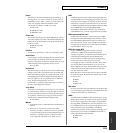
204
Glossary
Balanced connection
A method of transmitting signals using three electrical
conductors. This cancels any noise that may have entered
the line during transmission, allowing noise-free
transmission of low-level signals over long distances. This
method is usual on professional and broadcast equipment.
BPM, beats per minute
The number of beats in one minute (usually quarter note).
Coaxial
A digital audio connector to which a coaxial cable can be
connected. In contrast, a type of digital audio connector to
which an optical cable can be connected are referred to as
“optical.“ The CDX-1’s digital audio connector conforms
to S/P DIF.
➔ S/P DIF
➔ Optical
Condenser microphone
A type of microphone that applies the principle of a
condenser. It has excellent high-frequency response, and
allows more subtle nuances of sound to be captured.
Contrast
A setting that adjusts the difference between the light and
dark areas of a display. This controls the apparent
brightness of the display.
COSM
An abbreviation for Composite Object Sound Modeling.
Proprietary Roland technology for combining sound
models of various types to produce sound. Some of the
effect algorithms of the CDX-1 are implemented using this
technology.
DAT
Short for Digital Audio Tape. This refers both to the
system of recording digitized sound to magnetic tape, as
well as to the tapes themselves. Besides digital audio
signals, all song information is recorded on the tape,
including starts and track data, information to allow or
prevent copying, etc.
Dynamic microphone
A type of microphone that uses the same principle as an
electrical generator. It operates without a power source.
The most common types are quite durable, and are widely
used as vocal and instrument mics.
Effects
Special processes that modify or enhance the sound in
some way, such as causing it to distort, adding
reverberation, or delaying it, etc. Also used to refer to the
device or processor that produces the effect.
Effect patch
A state or settings that specifies an effect, stored under a
number or name. By recalling an effect patch you can
reproduce the state of the effect at any time.
Effect processor
A device that adds an acoustical effect such as
reverberation, distortion, or modulation. The CDX-1
contains a built-in effect processor. This manual may refer
to the “effect processor“ simply as “effect.“
Error message
A message that appears in the display when an incorrect
operation has been performed, or when data could not be
processed correctly.
Fade-in
Fade-out
Fade-in means to gradually raise the volume (for example,
at the beginning of a song). Fade-out means to gradually
lower the volume until silence is reached.
Fader
Faders are the sliders that are arranged on the panel of the
console, and used mainly to adjust the volume.
Formant
A fixed frequency region of emphasis that is determined
by the size of the vocal cords, and which determines the
character of a human voice. When a recorded voice is
simply lowered in pitch, the location of the formants is
also changed. For example when the pitch is raised, the
resulting “duck voice“ sounds as though the singer has
smaller vocal cords. Lowering the pitch produces a “giant
voice“ that sounds as though the singer has larger vocal
cords.
Format
When used as a verb, “format“ refers to the act of re-
writing the data storage divisions on a magnetic disk or
memory card etc. so that it conforms to the storage
methods used by a particular device. On the CDX-1, a
newly purchased CD-RW disc or one that has been used
by a different device must be formatted by this system
before it can be used. When a storage medium is
formatted, any data previously existing on that medium
will normally be lost.
Finalize
This is the operation that writes the TOC to a prepared
audio disc. Whereas additions and changes can be made to
discs that have not yet been finalized, such discs are not
playable on regular CD players.
Foot switch
A switch that is operated by stepping on it. Various
operations can be performed by pressing a pedal instead
of operating a button. This permits operation even while
both hands are occupied, such as when you are playing an
instrument.


















